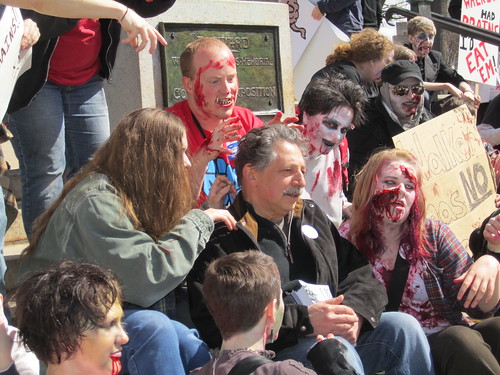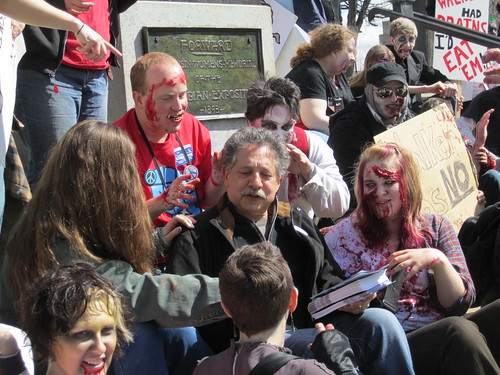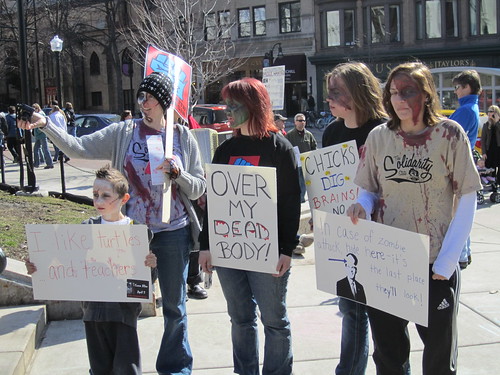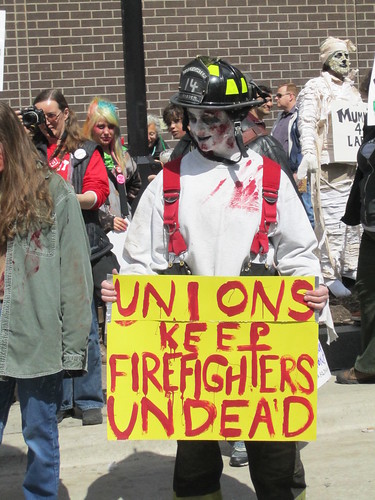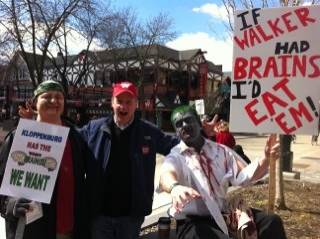Posted By John Sears on April 6, 2011
First, let me say, wow. This is one of the densest and most complicated analyses of Zombie media I’ve ever seen.
Second, of course, I have to say that it’s very deeply flawed and obviously incorrect on a number of points.
This PopMatters article, entitled ‘Zombies, Reavers, Butchers, and Actuals in Joss Whedon’s Work’, by Gerry Canavan, attemps to tease out the relationship of noted science-fiction/horror auteur Joss Whedon to the Undead, and more specifically, Zombies:
For all the standard horror movie monsters Joss Whedon took up in Buffy and Angel—vampires, of course, but also ghosts, demons, werewolves, witches, Frankenstein’s monster, the Devil, mummies, haunted puppets, the Creature from the Black Lagoon, the “bad boyfriend,” and so on—you’d think there would have been more zombies. In twelve years of television across both series zombies appear in only a handful of episodes.
A list of episodes and brief appearances follows, then he continues with:
That’s about it—and most of these don’t even really count as zombies at all. Many can talk, and most exhibit a capacity for complex reasoning and decision-making that is totally antithetical to the zombie myth. Not a one of these so-called zombies seems especially interested in devouring our heroes’ delicious flesh. Of the aforementioned episodes only “Dead Man’s Party” and “Habeas Corpses” really come close to evoking the wonderfully claustrophobic adrenaline rush of the shambling, groaning zombie horde that has become so popular in American horror since George Romero’s genre-establishing Night of the Living Dead series: a small group of people, desperately hiding within a confined, fortified space, with nowhere to run and no hope for survival when the zombies finally penetrate their defenses.
You begin to see the problem right away; although this article does go to pains to talk in some depth about Voodoo ‘zombi’ vs the Romero conception, it operates under a devastatingly critical flaw, even putting aside the fact that, yet AGAIN, a scholar has decided to discuss Zombies on screen with no mention of their actual status in society:
Canavan, and many others, think Romero is the Alpha and the Omega of American Pop Culture Zombiedom.
Even when he’s not.
Let me explain. Americans have an idea of what constitutes a ‘Zombie’. They also know that this idea comes from George Romero. The fact that many of the things they ascribe to their mental picture of a ‘Zombie’ are not, in fact, from the fertile mind of George Romero has no bearing on the matter; they know ‘Zombies’, and they know that they came from Romero.
Even when they didn’t.
First, despite his admiration for Romero, Whedon seems to exhibit a strong preference for the original Haitian zombi—a nightmarish transfiguration of slavery into a curse that continues even after death—over George Romero’s mindless, ravenous consumer of flesh. The American horror zombie is a corpse without a mind, wandering aimlessly in search of food and governed by pure instinct; the zombi, in contrast, is only sometimes a revivified corpse, and is more commonly a traumatized but still living person whose will has been replaced with the will of the zombie master and whose body has been put to work. Whedon fairly frequently makes his characters pedants on this point; in “Some Assembly Required” Giles scolds Xander when he suggests that zombies might feed on the living, and Wesley does the same thing to Gunn in Angel’s “Provider” (3.12), dismissing flesh-eating as a myth (though Wesley’s zombies still “mangle, mutilate, and occasionally wear human flesh”). Anya says it again in Buffy Season Six’s “Bargaining, Part I,” when Xander speculates that their resurrection spell might have accidentally turned Buffy into a zombie who will attempt to eat their brains: “Zombies don’t eat brains, anyway, unless instructed to by their zombie masters. Lotta of people get that wrong.” (Alas, Romero!)
And here we begin to see, yet again, the point where reality diverges from the critical and pop-cultural conception of the world, because most of these points are not, in fact, from George Romero.
Romero’s an Anti-Zombie bigot, don’t get me wrong, a Living Supremacist of the lowliest form, but.. these are not *his* Zombies.
Let’s start with the obvious: Romero Zombies don’t eat brains. How do I know this? Well, firstly, from having seen every single Romero depiction of ‘Zombies’ multiple times, from ‘Night of the Living Dead’ to ‘Survival of the Dead’, plus ‘Creepshow’, which has some very, very different Undead that stand as outliers in his work.
But also because George Romero told the whole world that his Zombies don’t eat brains, in an interview with Vanity Fair that ran under the title of, and I swear I’m not making this up, ‘George A. Romero: “Who Says Zombies Eat Brains?”‘:
Eric Spitznagel: To paraphrase Freud, sometimes things have symbolism and sometimes a cigar is just a cigar. Are the zombies in your movies always a metaphor, or are they sometimes just bloodthirsty walking corpses?
George Romero: To me, the zombies have always just been zombies. They’ve always been a cigar. When I first made Night of the Living Dead, it got analyzed and overanalyzed way out of proportion. The zombies were written about as if they represented Nixon’s Silent Majority or whatever. But I never thought about it that way. My stories are about humans and how they react, or fail to react, or react stupidly. I’m pointing the finger at us, not at the zombies. I try to respect and sympathize with the zombies as much as possible. (Laughs.)
…
Zombies have a weird fixation with eating human flesh and brains. What is it about being undead that makes somebody so ravenous?
First of all, why does everybody say that zombies eat brains?
Because… it’s true?
I’ve never had a zombie eat a brain! I don’t know where that comes from. Who says zombies eat brains?
I remember brains being a big zombie menu item in Return of the Living Dead back in the mid-80s, but I’m not sure if that’s where it started.
Whenever I sign autographs, they always ask me, “Write ‘Eat Brains’!” I don’t understand what that means. I’ve never had a zombie eat a brain. But it’s become this landmark thing.
There. Once again, I’m actually forced to help George Romero with his cinematic legacy, just to keep facts straight.
Romero’s Zombies are not what I’ll refer to hereafter as the ‘American Pop Culture Zombie’ at all, and they couldn’t be for Romero’s socially critical style of film-making to work. Zombies themselves, he claims, aren’t metaphorical; they just are. But what *are* they, for Romero? They’re shadows of humanity, and in those shadows we can see pieces of Living society.
Romero’s Zombies want things that Romero’s Living people want: security, company, to go through the motions of day to day life. To eat, naturally, although not brain. They’re portrayed as inferior knockoffs of humanity, but they still have some humanity in them. (Notably, they’re capable of learning, and they evolve over time in his films as the Apocalypse unfolds)
Thus Romero can contrast the negative stereotypes he’s created of Zombies with even *worse* examples of Living humanity, to say, ‘These people are *worse* than monsters.’
Of course, I don’t believe that Romero’s Zombies are entirely free of allegory, contra his interpretation; or to be more precise, the Zombies might be, but the Living characters in his film ascribe meaning to them, most famously consumerism in ‘Dawn of the Dead’.
So what kind of ‘Zombie’ is Mr. Canavan talking about? He’s talking about the American Pop Culture Zombie, of course.
That ‘Zombie’ eats human grey matter, is incapable of learning, and is a savage, rotting corpse that moves around on its own, muttering ‘braaaaaains’ a lot. It is also found in precisely no major works of Anti-Zombie fiction, but almost every academic or pop-academic treatment of Zombies. Like this one.
Sigh.
I mean, Romero’s Zombies form a civilization in ‘Land of the Dead’ and launch an amphibious invasion, and people still think that Romero Zombies are completely mindless.
So Mr. Canavan’s looking for a kind of Zombie that doesn’t exist in a series that wasn’t about them, and then using their absence as part of a theory about why Joss Whedon doesn’t utilize the American Pop Culture Zombie stereotype, which basically nobody ever has, since it only exists in the zeitgeist and not in any actual major iconic Zombie production.
Which leads to paragraphs like this:
That scene—like countless later scenes featuring such lovable and charismatic vampires as Angel, Spike, Drusilla, Dracula, The Master, Harmony, Mister Trick, and Holden—just wouldn’t work if a dead-eyed, lurching Darla were groaning incoherently, covered in pus and blood, her skin falling off. This is the difference between vampires and zombies: despite superficial similarities in appetite, bad skin, and ghastly undeath, vampires are characters, they are agents, they are (despite everything else) people. The popularity of the vampire as a figure for both transgressive heterosexual lust and queer sexuality—both on Buffy and in popular successors like True Blood—could never be located in the zombie, as the zombie is never a possible point of identification or romance but is always hopelessly, permanently, intractably Other. The Hollywood zombie popularized by Romero is not a person but a force of nature: it can’t be reasoned with, it certainly can’t seduce us, and it cannot ever be redeemed. It doesn’t want anything but to gnaw on your bones.
Again, Romero’s Zombies aren’t like that. Take Bub, from ‘Day of the Dead’:
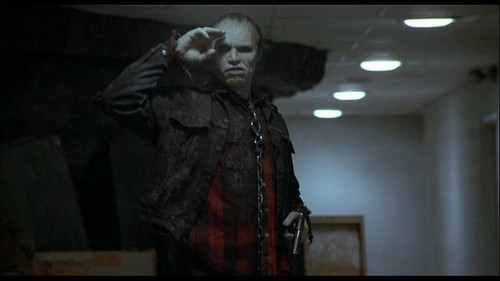
Bub isn’t just capable of learning, he has actual human feelings, which most of the deeply disturbed Living characters lack. Notably, in the entire movie, he’s the only one who mourns the death of another person:

Vampires, of course, are not always ‘agents’ in fiction either. Indeed, as Canavan notes, Whedon is inconsistent on this point throughout his Buffy/Angel runs, with vampires being characters seemingly whenever it was more interesting to write them that way.
From there the piece goes on to formulate a grand theory of Whedon’s writing and characterization, which is not really relevant here, and then to analyze subsequent character types in ‘Firefly’ and ‘Dollhouse’ as if they were Zombies, which is interesting at times, and at times is a real stretch. The post-modern Manchurian Candidates in ‘Dollhouse’ strike me less as an image of Zombiism than as the dark mirror image of posthumanity in Cory Doctorow’s fiction (‘Down and Out in the Magic Kingdom’ for example); a kind of human being so changed by technology and circumstance that they’re people, but not people we can really connect with from our side of the Singularity, and who might not have much use for us. A Zombie is a person in a fundamentally non-conventional form, hence ‘Differently Animated’, whereas a Doll is a conventional human form with something else inside, a person perhaps, but not one we understand. I guess. I never watched the show, I’m cribbing on that one a bit.
‘Firefly’ of course has the Reavers, who also don’t resemble conventional Zombies of any sort to me. They’re much more like a Lovecraftian plague of insanity, a cursed tribe of once-people who have fallen sway under a god of madness; Innsmouth by way of the stars. They’re not biologically Different from baseline humans; they’re just nuts. Really, really nuts. Stared into the face of uncaring God nuts.
In all these cases, Canavan tries to fit the varyingly shaped puzzle pieces of Whedon alt-humanity into the spot he, and millions of other Americans, have carved out in their head for ‘Zombie’, and of course fails. Along the way you get gems like this:
In accordance with this political prehistory of the zombie, the last hour of Serenity is one long, continuous reprisal of that ubiquitous scene in zombie cinema in which a live human must attempt to pass for a dead one in order to escape an otherwise hopeless situation—only our characters aren’t exactly pretending.
Ubiquitous? Really? It’s not in any Romero Zombie film, it’s not in Raimi’s work or Boyle’s, it’s not in ‘Return of the Living Dead’, it’s not in any major Zombie videogame that I know of. It is in several very *recent* Anti-Zombie products; “Shaun of the Dead”, “The Walking Dead” and so forth, parodied perhaps in “Deadpool: Merc with a Mouth”. But, again, it’s hard to think of any seminal work of Zombie cinema from before the end of the millenium where this is a major plot element.
It is rapidly becoming a component of the mainstream American Zombie mythos, however.
As the vanguard of the Zombie Rights Movement, the ZRC sees and consumes a lot, and I mean a *lot* of Zombie related media, and the thing that has been most striking, beyond the appalling lack of sympathy found in most of it, is the sheer variety. There is no one type of fictional Zombie, for good or bad, even in just one country, like the United States. Yet time after time after time we’ve run across people who are utterly convinced of this unifying, counterfactual scenario, and certain that they know what a ‘Zombie’ should be. They usually cite the same movies and influences, almost always Romero, and, like Mr. Canavan, they’re almost invariably wrong, not just on the overall concept, but about their specific citations.
Which is why George Romero goes on record with Vanity Fair in exasperation about how often he has to correct his own supposed fans.
Does no one actually watch, or play, or read the Anti-Zombie media they consume, except for us? I’m beginning to wonder. Perhaps it’s less like entertainment and more like a palliative, where academics and laypeople alike take hits to assuage some craving or remove some pain that they don’t understand, and then ignore everything that happens in front of them which doesn’t conform to the idea they had before they ever picked up the DVD, bought the tickets or opened the book.
If so, analyses like ‘Zombies, Reavers, Butchers, and Actuals in Joss Whedon’s Work’ aren’t about Zombies, or about American Pop Culture Zombies, or about Zombie fiction creators. They’re about a societal mass that has retreated almost entirely into self-indulgence, a cheerless exercise in mental masturbation, cued in almost Skinnerian fashion by a stimulus they label ‘Zombie’ after the fact.
Category: Zombie Media |
No Comments »
Tags: Academia, Journamalism



